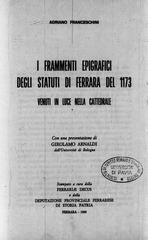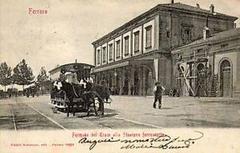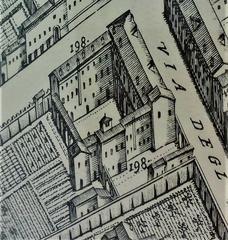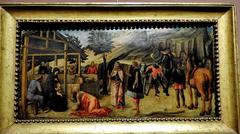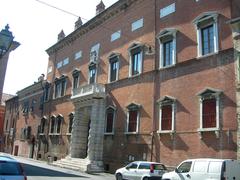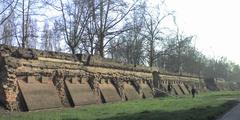
Baluardo di San Rocco: Visiting Hours, Tickets, and Historical Insights in Ferrara
Date: 03/07/2025
Introduction
The Baluardo di San Rocco, once a formidable bastion within Ferrara’s renowned Renaissance city walls, stands as a symbol of the city’s military innovation and urban sophistication. Although the original structure was demolished in the 19th century, its legacy endures through well-marked green spaces, interpretive signage, and its central role in Ferrara’s UNESCO World Heritage fortifications. Today, the site is an essential destination for history enthusiasts, architecture lovers, and visitors seeking to immerse themselves in Ferrara’s unique blend of heritage and nature. This comprehensive guide outlines the bastion’s historical significance, current visitor information, accessibility, nearby attractions, and practical travel tips to enhance your experience (Ferrara Terra e Acqua, Inferrara).
Table of Contents
- Historical Background
- Visiting the Baluardo di San Rocco
- Visuals and Maps
- Frequently Asked Questions (FAQ)
- Conclusion and Planning Resources
Historical Background
Origins and Strategic Context
The Baluardo di San Rocco was constructed in the early 16th century as part of Ferrara’s ambitious city wall modernization, commissioned by the Este dynasty to defend against evolving artillery threats. Positioned at the southwestern perimeter, it formed a critical node in Ferrara’s defensive circuit, integrating seamlessly with other bastions such as Sant’Antonio and dell’Amore (Ferrara Terra e Acqua). Designed by leading military engineers of the era, its arrowhead or “ace of spades” shape provided overlapping fields of fire and minimized blind spots, exemplifying Renaissance military engineering (inferrara.it).
Although the bastion was demolished between 1862 and 1872, its foundations remain visible, outlined by hedges and interpretive panels that help visitors imagine its original form (Museo Ferrara).
Architectural Features
The bastion was constructed from brick, stone, and packed earth, with thick ramparts designed to absorb cannon fire. Its design reflected the “trace italienne” or star fort style, which marked a shift from medieval curtain walls to angular bastions able to withstand gunpowder artillery. The site’s layout and surviving remnants offer a tangible link to Ferrara’s layered military history (Ferrara Terra e Acqua).
Visiting the Baluardo di San Rocco
Hours and Access
- Opening Hours: The site is open to the public 24/7, year-round, as part of Ferrara’s extensive green spaces and city wall circuit.
- Location: Situated near Ferrara’s historic center, the Ex Baluardo di San Rocco is accessible on foot, by bicycle, or via public transportation. Nearby landmarks include Porta Paola, Castello Estense, and the Cattedrale di San Giorgio (Komoot, Mapcarta).
Tickets and Accessibility
- Tickets: Entry to the site and surrounding park areas is free; no tickets or reservations are required.
- Accessibility: The site features mostly flat, gravel or compacted earth paths suitable for wheelchairs and strollers; some sections may be uneven after rain. Well-lit in the evenings, it is safe and welcoming to all visitors.
Guided Tours and Events
While there are no regular guided tours focused exclusively on the Ex Baluardo di San Rocco, local tourism offices and heritage groups offer walking and cycling tours that include this bastion as a highlight. These tours provide in-depth historical context and can be booked in advance (Inferrara).
Seasonal events, such as open-air concerts and historical reenactments, are occasionally held along Ferrara’s walls and may include the area around San Rocco (Visit Ferrara).
Travel Tips
- The bastion is best reached by foot or bicycle; Ferrara is renowned for its flat terrain and extensive cycling paths.
- Wear comfortable shoes, especially for exploring the full circuit of the city walls.
- Spring and autumn offer the most comfortable weather and vibrant scenery.
- Early morning and late afternoon visits provide excellent lighting for photography and are generally less crowded.
- Public restrooms and water fountains are available at intervals along the walls.
Nearby Attractions
Complement your visit to the Baluardo di San Rocco with other Ferrara landmarks:
- Porta Paola: Monumental city gate and walls documentation center.
- Castello Estense: Iconic moated castle.
- Cattedrale di San Giorgio: Ferrara’s principal cathedral.
- Via delle Volte: Medieval street known for its arcades.
- Parco Massari: Expansive city park for relaxation after your walk or ride.
Visuals and Maps
- Images: Panoramic views of Ferrara’s city walls and the green spaces where Baluardo di San Rocco once stood.
- Alt text example: “Ex Baluardo di San Rocco along Ferrara’s Renaissance walls.”
- Maps: Interactive routes and cycling/walking paths are available on official tourism websites and the Audiala app, helping you plan your circuit around the city walls.
Frequently Asked Questions (FAQ)
Q: Are there entrance fees or tickets required to visit the Ex Baluardo di San Rocco?
A: No, access is free and open to the public at all times.
Q: What are the visiting hours?
A: The site is accessible 24/7 throughout the year.
Q: Is the site wheelchair accessible?
A: Yes, most paths are accessible, though some sections may be uneven after rain.
Q: Are guided tours available?
A: Guided tours that include the site are offered by local operators and require advance booking.
Q: What is the best time of year to visit?
A: Spring and autumn offer mild weather and comfortable conditions for outdoor exploration.
Q: Are there facilities such as restrooms and refreshments nearby?
A: Public restrooms and water fountains are available along the walls, with cafés and trattorias a short distance away.
Conclusion and Planning Resources
The Ex Baluardo di San Rocco encapsulates Ferrara’s legacy as a Renaissance stronghold, blending historical intrigue, urban greenery, and modern accessibility. Though the original bastion has been lost, its memory is preserved through site markings, digital reconstructions, and community events. The area’s integration into Ferrara’s cycling and pedestrian networks makes it ideal for sustainable tourism and immersive exploration. For the best experience, plan your visit with resources such as the Audiala app, Ferrara’s official tourism websites, and local visitor centers (Ferrara Terra e Acqua, Inferrara, Visit Ferrara).
References and Further Reading
- Ferrara Terra e Acqua
- Inferrara.it
- Wandering Italy
- Comune di Ferrara
- Visit Ferrara
- Komoot
- Museo Ferrara
- UNESCO World Heritage Centre
- The Guardian


